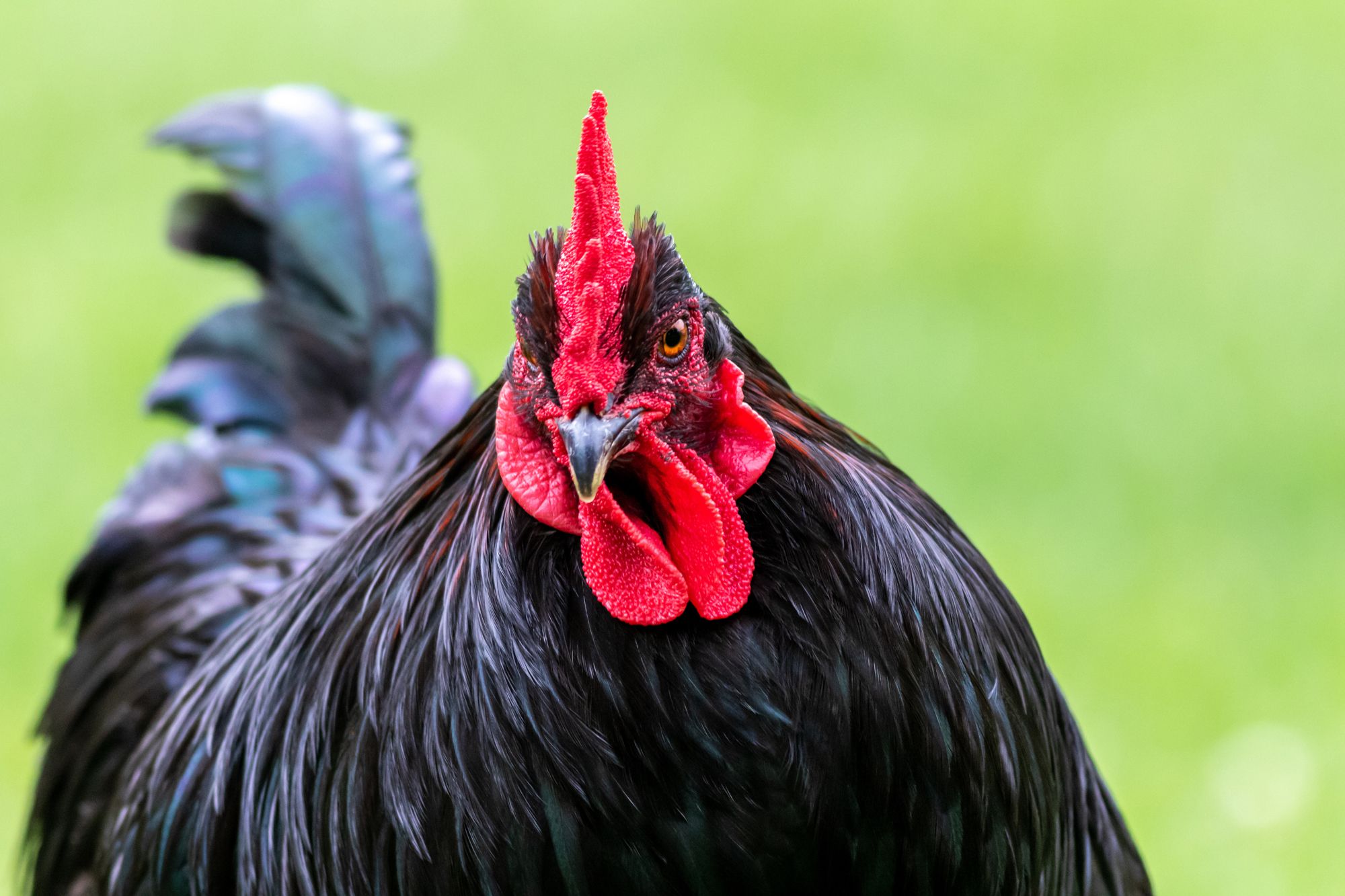Raising Broilers Indoors vs. Outdoors Trial
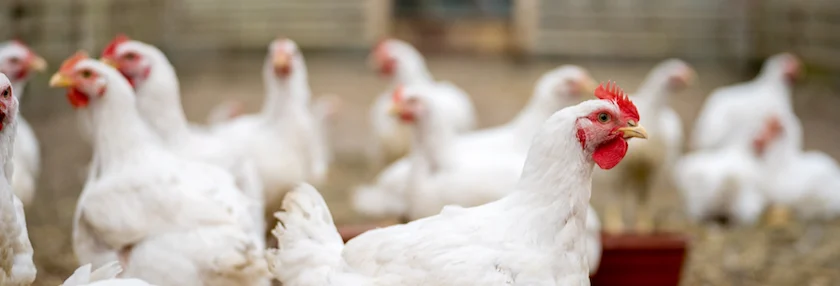

Putting numbers to the difference
Pasture versus pens—on which do chickens thrive?
This is an experiment comparing the Hatching Time 4-Layer 15 inch Grow Out Pen versus outdoor movable pens on pasture that allow birds to express their natural foraging behaviors.
This wasn’t without challenges: During the month of this trial, a week of thundershowers drenched the feeders and the birds. In addition, temperatures spiked and a couple of birds were lost to heat stroke near the end of the trial.
The equipment used
The Hatching Time Grow Out Pens made life uncomplicated. Assembly was easy—you just line up the arrows. The water system is built in and the feeders are simple to remove. Between each level of the Grow Out Pen are manure trays that are easy to remove, scrape, spray, and replace.
Although not light, each unit, once assembled, is on wheels and can be quickly and easily rolled wherever you want it.
In contrast, the outdoor pens were flimsy and disappointing: Most of the main connections were via thin, weak, and easily-rusted staples. The wood was luan plywood (at best) making the pens light to move, but as we found out later, they did not stand up to daily movement very well. The simple design lacked handles which would have been handy when moving the pen. Finally, the doors never shut properly on the top, and had to be bungeed shut—eventually the bungees started to pull the staples out.
The movable pens were 59 inches long, 39.5 inches wide, and 19.75 inches tall. These outdoor pens were moved every day to provide the broilers with fresh forage.
At $200 per pen, I did not get my money’s worth. By my estimation, I would not spend more than $40 on one of these pens.
The trial design
One hundred broiler chickens were brooded for two weeks and then randomly sorted into either the indoor Hatching Time Grow Out Pens or the outdoor pens. There were four outdoor pens and ten chickens were placed in each pen. That means there were four replicates and a total of 40 chickens outdoors.
For indoors, each level of the Hatching Time Grow Out Pen held three broilers and there were four levels to each unit. That means there were a total of 12 broilers per indoor grow out pen. With four Grow Out Pens, a total of 48 chickens were raised indoors.
Throughout the four-week trial, all chickens were fed Tucker Milling’s Show Flock Developer Diet, a 20% crude protein pelleted diet. Chickens had access to fresh clean water and feed at all times. The outdoor pens were placed on a grass and clover blend that was no taller than 3 inches at any time during the course of the trial.
The average body weight of the broilers in both groups were the same at the start of the trial (Figure 1). But as the trial progressed, the two groups were nearly identical in the weight of the broilers. That is, until the end of the trial—the broilers outdoors were nearly ¾ of a pound heavier.
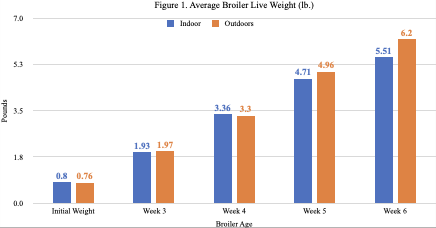
This was especially surprising because the weather at the end of the trial spiked to daytime highs of 85° F. The lows at night went down to approximately 75° F. Humidity during the last week remained above 80%, making it challenging for birds to shed heat. Recall we had two bird losses due to heat stroke, despite having enough water.
In order to keep the birds in shade, the rotation of the pens had to be adjusted to move the birds back over pasture that had already been grazed once.
There was also an incident one evening when a Great Horned Owl broke into one of the outdoor pens and killed two broilers. Whether the flimsiness of the wood caused the owl to fall in when it landed on the pen or if the bird manipulated the structure to gain access remains unknown. After killing two broilers, it could not find the exit.
Once the owl was removed, repairs to the coop were made in the dark and reinforced the next morning so no further break-ins occurred during the trial.
If you look at Figure 2, it is not surprising that the amount of feed consumed by the outdoor group of broilers was greater.
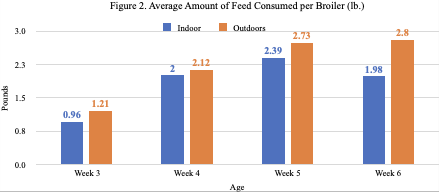
Several studies have examined this detail, and here is how it works: Chickens outdoors move around more as a part of their natural foraging habits. As a consequence, they consume more feed even though they are also consuming forage and insects.
Forage, in the form of the clover and grass blend in this case, does not provide sufficient nutrition to meet the needs of a fast growing broiler. Even the insects consumed do not sufficiently balance out the additional needs of the flock. Interestingly, the consumption of feed for the chickens raised indoors decreased in the last week. This is likely due to the heat wave. Regardless, each broiler was consuming between two and three pounds of feed per bird.
An overall comparison of the feed consumed (Figure 3), shows both groups essentially ate the same amount. There was only a 19.2 lb. difference in the overall amount of feed eaten between the chickens indoors and those outdoors.
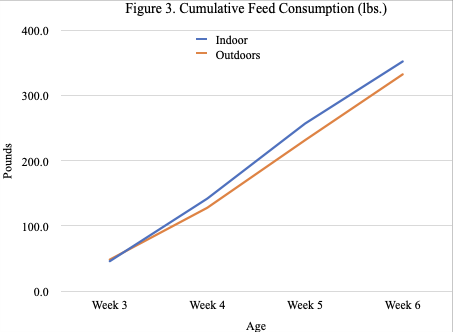
The indoor chickens ate more, consuming 351.8 pounds. and the outdoor chickens consumed 332 pounds. If you recall from Figure 2, the indoor chickens ate less on average, but remember is that the indoor group had more chickens in it than the outdoor group and that makes a difference in the overall amount of feed consumed by the group.
In my area of the county, a 50 lb. bag of Tucker Milling Show Flock Developer costs approximately $19 a bag. So that means that I spent $126.16 to feed them a grower ration for 40 birds outdoors and $133.69 to feed 48 birds indoors. (Which is not bad for 4 weeks of grow-out!)
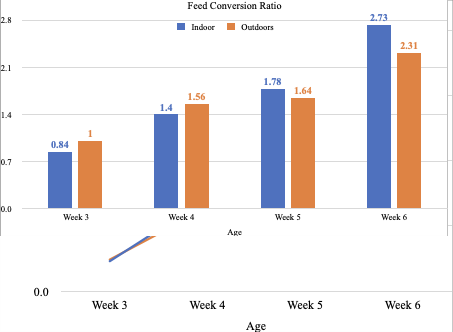
Did that feed actually turn into body weight? The feed conversion ratio will tell us if the birds were actually efficient at converting that feed into broiler meat.
A 1:1 ratio would mean that it takes one pound of feed to make one pound of meat. As the chickens grew, both groups became less efficient. While the indoor group did great in the first two weeks, they became less efficient than the outdoor group during the final two weeks of growing.
Labor issues
The last detail that was measured in this trial was time, meaning labor. It was almost immediate that there was going to be a large discrepancy in the amount of labor required to care for the two sets of birds.
The outside set needed to have their feed replaced more regularly—a series of storms soaked the feed. Then there was the daily process of moving the cumbersome pens. The chickens never did get into the rhythm of moving with the pen, slowing the process.
Even though the pens were moved only about 60 inches a day, it could sometimes take 3-4 minutes to convince the birds to move along with he pens. Multiply that by 4 pens and you were spending just under 15 minutes a day moving the pens.
Then there was the water which needed to be checked and filled daily and that took another 5 minutes. The watering system outside used the Premier 1 Supply Yellow Bowl automatic drinker with a 2.5 gallon bucket as the reservoir, with two yellow drinkers per pen. These drinkers leaked quite a bit and toward the end of the trial, so the buckets would need refilling twice a day. Broilers not only drink a lot, but they dripped, and the weather turned warm. The feeders were also smaller and needed filling more often.
So, spending and average of 24 minutes every day in just maintenance of the outdoor flocks is not a terrible amount of time for 40 birds.
In comparison to the Hatching Time Grow Out Pens, the time difference was significant. Water tanks in the Grow Out Pens were easy to see from a distance and gauge when they needed refilling. The indoor chickens used the water more efficiently since they used nipple drinkers.
Once the feeders were filled on the front of the Grow Out Pens, a quick glance showed when refill was indicated. In come cases feed just needed to be scooted toward the front of the feeder in places where the chickens had eaten the most.
The average amount of time, checking on and caring for the indoor group was just under three minutes. That includes time spent a couple days a week refilling the water tanks. Weekly or bi-weekly scraping and cleaning of the trays beneath each level of the Grow Out Pens was the most time-consuming, but was easily accomplished.
Thus, there is an 8-fold difference in time spent caring for the chickens indoors—it took eight times longer to care for the outdoor chickens even though there were fewer of them.
Practical peace of mind
Having these chickens in a secure garage was a huge relief after the owl attack in the outdoor pens. Those worries simply did not exist with the Hatching Time Grow Out Pens.
I am 100% sold on how much less stress and easier these chickens were to care for.
Yes, the chickens in the indoor group were just under ¾ of a pound smaller, but they also ate less and I spent just a little less money on feed for them. Both groups were almost neck and neck on feed conversion ratio until the weather turned hot, making me wonder if conducting this trial at a different time of year would yield different results.
The peace of mind that the Hatching Time Brooder brought me cannot be measured and it is now my go-to broiler raising method. The Hatching Time Grow Out Pen is worth every penny in my opinion.
Tags:Hot Topics

Chicken Whisperer is part of the Catalyst Communications Network publication family.








